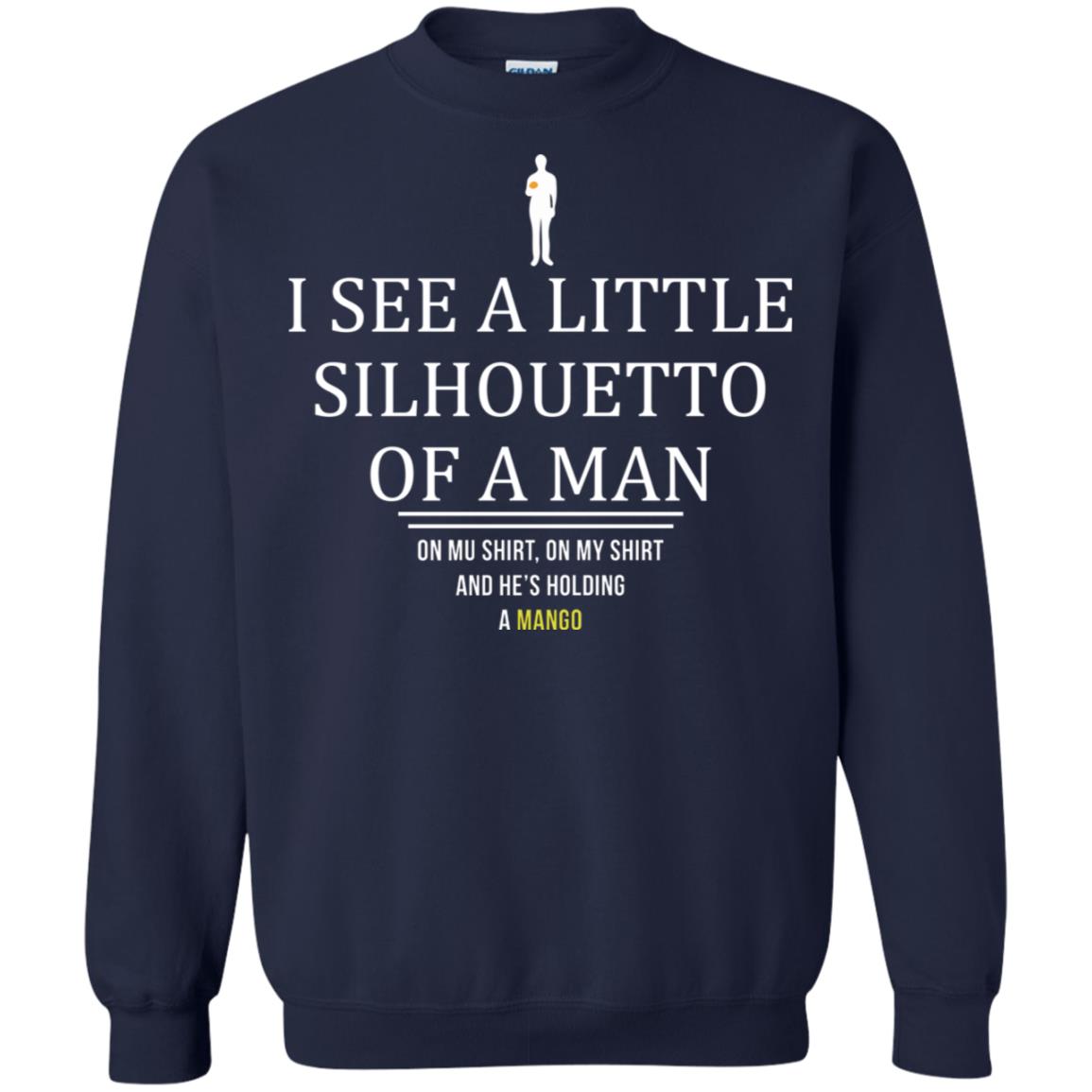There's something hauntingly beautiful about the phrase "I see the little silhouetto of a man." It's one of those lines that sticks with you long after the music fades away. At first glance, it might seem like just another lyric from Queen's iconic song "Bohemian Rhapsody." But when you dig deeper, it becomes clear that this line carries so much weight and symbolism. It's almost like a riddle waiting to be solved. So, what exactly does it mean? And why has it resonated with millions of fans around the globe?
Let's set the stage for a moment. Picture yourself in 1975, sitting in a dimly lit room with a record player spinning Queen's masterpiece. As Freddie Mercury's voice soars through the air, these words paint an image—a silhouette of a man standing alone under the moonlight. It’s eerie yet mesmerizing, evoking emotions that are hard to put into words. For decades, fans have debated the meaning behind this phrase, turning it into more than just a lyric—it’s a cultural phenomenon.
What makes "I see the little silhouetto of a man" so fascinating is its ambiguity. Is it about guilt? Redemption? Loneliness? Or maybe it’s all of the above. Whatever the interpretation, one thing is certain: this line taps into something deeply human, resonating with listeners on a personal level. So, let’s dive in and explore the layers of meaning behind this unforgettable phrase.
Read also:Box Braids In Popeyes The Ultimate Guide To This Trendy Hairstyle
Table of Contents
- Origins of "I See the Little Silhouetto of a Man"
- The Genius of "Bohemian Rhapsody"
- Unpacking the Symbolism
- Freddie Mercury: The Visionary Behind the Lyrics
- Different Interpretations of the Line
- Psychological Meaning Behind the Silhouette
- Cultural Impact and Legacy
- How This Line Changed the Music Industry
- Modern Relevance of the Lyrics
- Final Thoughts
Origins of "I See the Little Silhouetto of a Man"
If we rewind the clock to the early 70s, Queen was already making waves in the music scene. But it wasn't until "Bohemian Rhapsody" that they truly cemented their place in history. Written by Freddie Mercury, the song is a six-minute masterpiece that defies genre boundaries. Among its many memorable lines, "I see the little silhouetto of a man" stands out as one of the most enigmatic. But where did this line come from?
Freddie often drew inspiration from his personal experiences, dreams, and even nightmares. Some believe this particular line was inspired by a vivid dream he had, while others think it reflects his inner struggles with identity and acceptance. Regardless of its origin, the line perfectly encapsulates the operatic section of the song, adding a dramatic flair that captivates listeners.
Why This Line Stands Out
What makes "I see the little silhouetto of a man" so powerful is its ability to evoke imagery without being overly descriptive. The use of "silhouetto" instead of "silhouette" adds a playful twist, hinting at Freddie's love for wordplay. Moreover, the phrase acts as a bridge between the ballad and operatic sections of the song, tying the narrative together seamlessly.
The Genius of "Bohemian Rhapsody"
Before we delve deeper into the meaning of "I see the little silhouetto of a man," it's important to understand the context of "Bohemian Rhapsody." This song is not your typical rock anthem; it's a complex narrative that combines elements of rock, opera, and ballad. It tells the story of a man who commits a crime and seeks redemption, all while grappling with existential questions.
The operatic section, in particular, is a whirlwind of emotions, with rapid-fire lines sung by multiple voices. "I see the little silhouetto of a man" appears during this chaotic yet harmonious part, serving as a moment of clarity amidst the chaos. It's as if the protagonist sees himself—or someone else—standing in the shadows, a symbol of guilt or regret.
Breaking Down the Operatic Section
- This part of the song features multiple vocal layers, creating an orchestra of voices.
- The lyrics are filled with cryptic phrases, leaving room for interpretation.
- "I see the little silhouetto of a man" serves as a focal point, drawing attention to the central theme of identity and reflection.
Unpacking the Symbolism
Now, let's talk about the symbolism behind "I see the little silhouetto of a man." On the surface, it might seem like a random observation. However, if you look closer, you'll find layers of meaning hidden within. A silhouette is often associated with mystery and ambiguity, representing something that's partially visible but not fully understood. In this context, the man could symbolize the protagonist's darker side, his past mistakes, or even his own mortality.
Read also:Cintia Cossio Unveiling The Truth Beyond The Controversy
Moreover, the use of "little" adds a sense of vulnerability. It suggests that the man is small in comparison to the forces around him—be it society, fate, or his own conscience. This vulnerability is a recurring theme in "Bohemian Rhapsody," reflecting the struggles of the human condition.
Key Symbolic Elements
- Silhouette: Represents mystery, identity, and the unknown.
- Man: Could symbolize guilt, regret, or the protagonist's inner self.
- Little: Emphasizes vulnerability and the fragility of human existence.
Freddie Mercury: The Visionary Behind the Lyrics
Any discussion about "I see the little silhouetto of a man" would be incomplete without mentioning Freddie Mercury. As the mastermind behind "Bohemian Rhapsody," he brought a unique perspective to songwriting. Known for his flamboyant stage presence and incredible vocal range, Freddie was also a deeply introspective artist who poured his soul into his work.
Born Farrokh Bulsara in Zanzibar, Freddie grew up in a multicultural environment that influenced his music. He was a perfectionist who spent countless hours crafting each song, ensuring every detail was just right. "Bohemian Rhapsody" was no exception, taking over three weeks to record and perfect. His dedication to artistry is evident in every note and lyric, including the unforgettable "I see the little silhouetto of a man."
Freddie Mercury's Legacy
Freddie's impact on the music industry extends far beyond Queen. He redefined what it meant to be a rock star, blending different genres and breaking barriers along the way. His influence can still be seen in today's music, inspiring countless artists to push boundaries and express themselves freely.
Different Interpretations of the Line
One of the reasons "I see the little silhouetto of a man" resonates so deeply is because it allows for multiple interpretations. Fans and critics alike have offered their takes on what the line might mean. Here are a few popular theories:
- Guilt and Redemption: The man in the silhouette could represent the protagonist's guilty conscience, reminding him of his past actions.
- Identity Crisis: Some believe the line reflects the struggle to accept one's true identity, especially in the face of societal pressures.
- Mortality: Another interpretation suggests that the silhouette symbolizes the inevitability of death, urging the listener to confront their fears.
Ultimately, the beauty of this line lies in its versatility. It means something different to everyone, making it a timeless piece of art.
Why Interpretation Matters
Interpretation is key to understanding art, and music is no exception. By allowing listeners to draw their own conclusions, Freddie Mercury created a song that transcends time and culture. It's this openness to interpretation that keeps "Bohemian Rhapsody" relevant even today.
Psychological Meaning Behind the Silhouette
From a psychological perspective, "I see the little silhouetto of a man" can be seen as a metaphor for self-reflection. The silhouette represents the parts of ourselves we try to hide or ignore. By acknowledging its presence, the protagonist takes the first step towards healing and growth.
Moreover, the line touches on the concept of the "shadow self," a term coined by psychologist Carl Jung. According to Jung, the shadow self is the unconscious part of our personality that contains repressed weaknesses, desires, and instincts. Recognizing and integrating this shadow is essential for personal development.
Applying Psychology to Music
Music has a unique ability to tap into our subconscious, bringing to light emotions and thoughts we might not otherwise express. "Bohemian Rhapsody" does exactly that, using "I see the little silhouetto of a man" as a catalyst for introspection. It's a reminder that we all have shadows, and it's okay to face them head-on.
Cultural Impact and Legacy
Since its release in 1975, "Bohemian Rhapsody" has become a cultural touchstone. It's been covered, parodied, and referenced countless times in movies, TV shows, and advertisements. The line "I see the little silhouetto of a man" has even found its way into popular culture, becoming a meme in its own right.
But the song's influence goes beyond entertainment. It has inspired generations of musicians and fans alike, proving that music has the power to unite people across borders and languages. Its enduring popularity is a testament to Freddie Mercury's genius and Queen's timeless appeal.
How the Line Shaped Pop Culture
The phrase "I see the little silhouetto of a man" has become a shorthand for mystery and intrigue. It's often used in memes and parodies to add a touch of drama or humor. While some might argue that this dilutes its meaning, others see it as a sign of its lasting impact. After all, if a line from a 40-year-old song can still make people laugh or think, it's done its job well.
How This Line Changed the Music Industry
When "Bohemian Rhapsody" was first released, it broke all the rules. It was too long, too complex, and too unconventional for mainstream radio. Yet, it became a massive hit, proving that audiences were ready for something different. The success of the song paved the way for other artists to experiment with their music, pushing the boundaries of what was considered acceptable.
"I see the little silhouetto of a man" played a crucial role in this revolution. Its unexpected appearance in the operatic section added an element of surprise, keeping listeners engaged and intrigued. It showed that lyrics didn't have to be straightforward to be impactful.
Lessons for Modern Artists
Today's musicians can learn a lot from Freddie Mercury's approach to songwriting. By embracing ambiguity and allowing listeners to interpret his work, he created music that stood the test of time. In an era dominated by instant gratification, this lesson is more important than ever.
Modern Relevance of the Lyrics
Fast forward to 2023, and "I see the little silhouetto of a man" remains as relevant as ever. In a world where mental health awareness is on the rise, the line's exploration of identity and vulnerability strikes a chord with modern audiences. It reminds us that it's okay to feel lost or unsure, and that seeking help is a sign of strength, not weakness.
Moreover, the song's message of acceptance and self-discovery resonates with younger generations who are redefining what it means to be authentic. Whether it's through music, art, or social media, people are sharing their stories and finding common ground with others who have walked similar paths.
Connecting Past and Present
What makes "Bohemian Rhapsody" so special is its ability to connect past and present. It speaks to universal truths that transcend time and culture, reminding us that we're all human at the end of the day. And that's something worth celebrating.
Final Thoughts
So, there you have it—the story behind "I see the little silhouetto of a man." From its origins in Freddie Mercury's mind to its place


